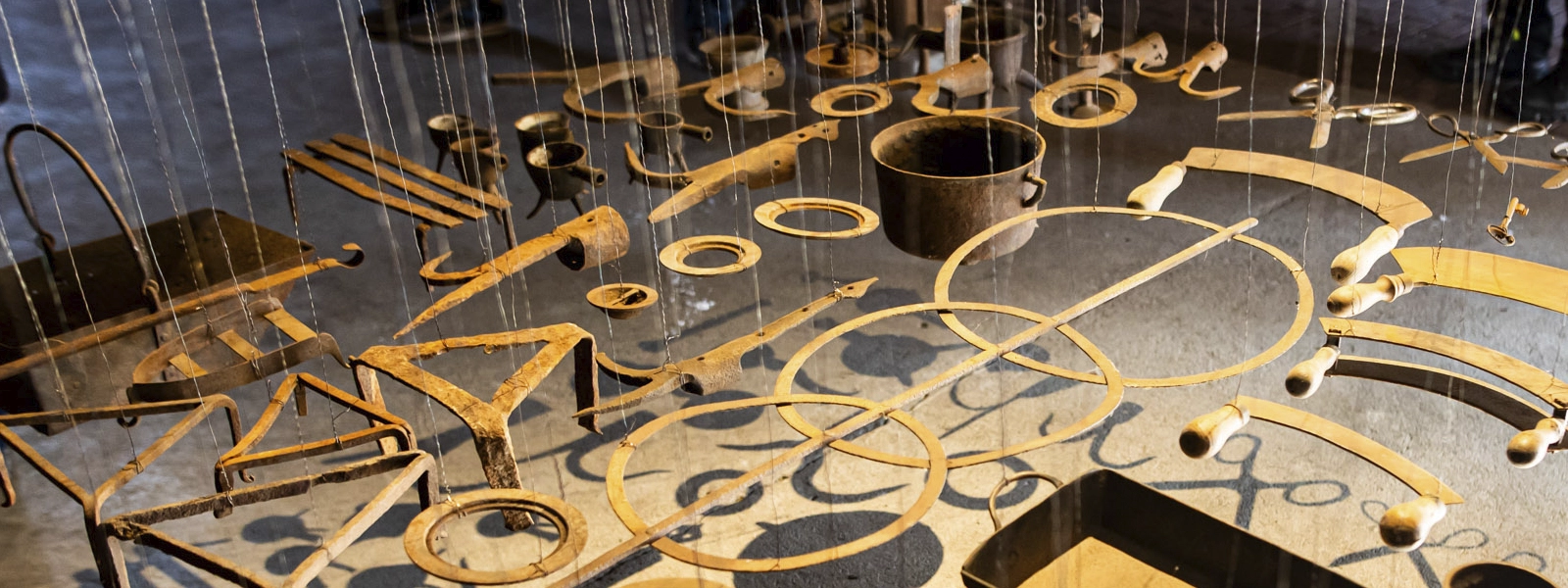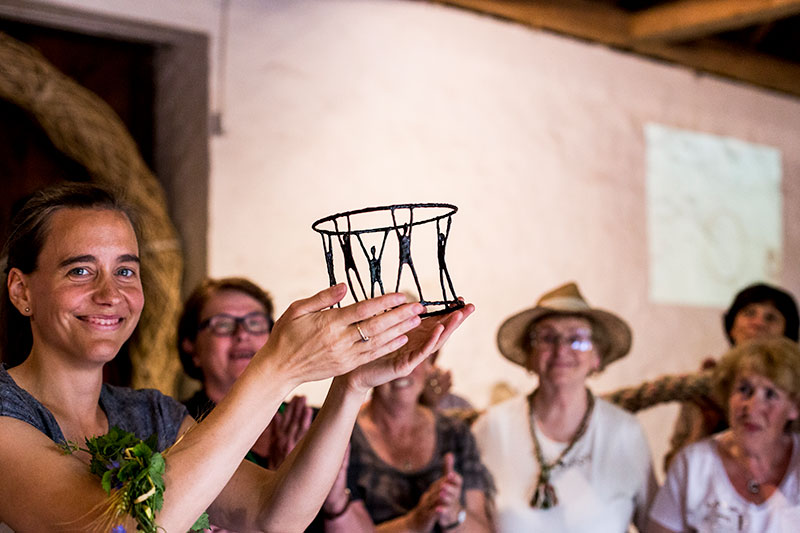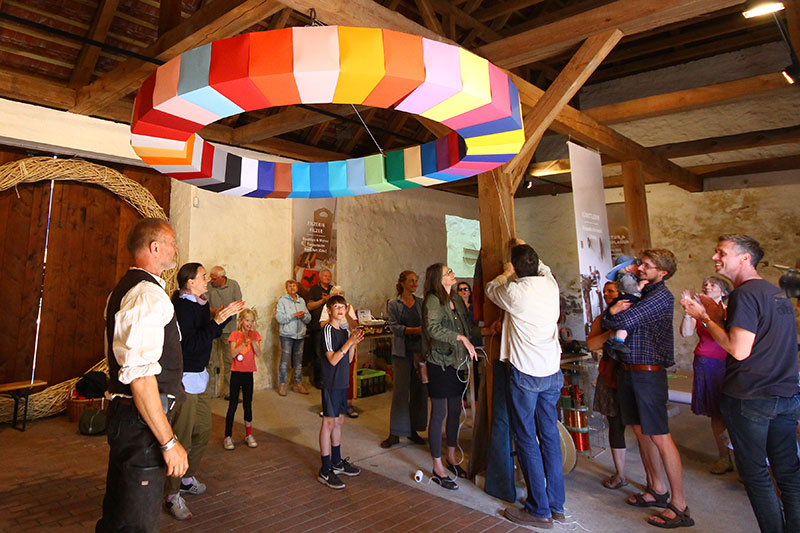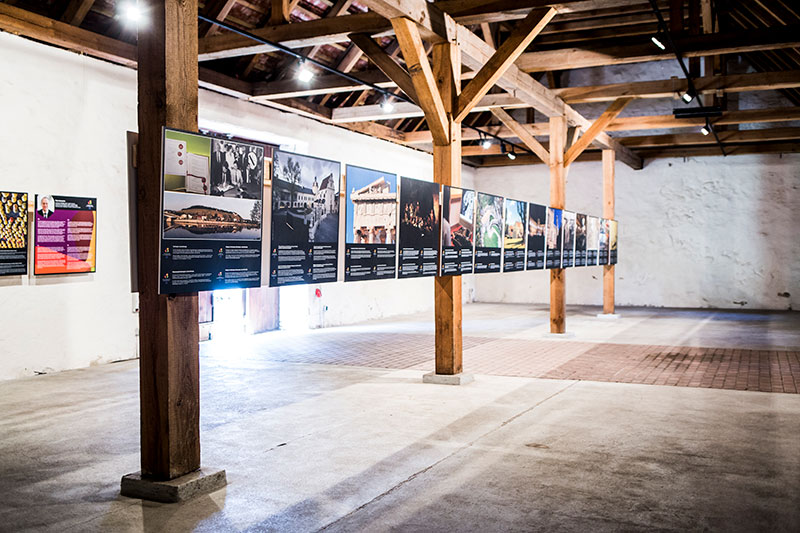
A magic of work
Historical wrought-iron tools and everyday objects in an installation by Antje Scholz
This collection of historical wrought-iron tools and everyday objects, which was created between 1980 and 2020 by Manuel Rößler, Berlin, comprised 60 boxes and a number of items that do not fit into boxes. Some could hardly be lifted. They are pieces of equipment that depict areas of craftsmanship and rural life. We selected objects from all these boxes, mostly from the Oderbruch region, arranged them in a certain order and let them float: Piece after piece was painstakingly arranged with wire into horizontal or vertical surfaces and hung on poles.
There is an identification booklet for each installed "area". It contains information about the equipment in terms of its use, which you are welcome to add to, as well as the respective locations. These were often village rubbish dumps, but also intact farmsteads in the villages in the Lusatian lignite mining areas that were cleared for excavation.
Room Archive

The industrialist and social reformer Max Bahr (1848-1930)
An exhibition of the Brandenburg State Archives from May 6 to September 30 at the Oderbruch Museum Altranft
Max Bahr from Landsberg an der Warthe had a decisive influence on the history of Brandenburg at the turn of the 20th century. As a merchant, he expanded the manufacture of jute products. From 1905, he was one of the largest employers in the region with his jute factory. His business and personal contacts reached all over the world and took him as far as America and India.
In conjunction with his entrepreneurial success, he built hundreds of workers' apartments, a people's bath and the People's Welfare House as a center of social life. He worked persistently to improve the living conditions of his workers, equal opportunities and the sociopolitical advancement of women. Until 1924, Bahr worked for the German Democratic Party in the first Weimar Reichstag, primarily on social and housing policy. He remained a determined defender of the Republic until his death in 1930. The People's Bath, the factory and the workers' houses still characterize the face of Gorzów Wielkopolski today. Bahr's actions as a socially committed, successful entrepreneur and at the same time progressive democrat deserve attention to this day.
The exhibition showed his commitment to economic and social progress, equal opportunities and dialogue, which is still exemplary today. Dr. Falko Neininger of the Brandenburg State Archives, who initiated the exhibition, writes: "In Bahr's case, it becomes clear that the history of Brandenburg cannot be told without looking across the Oder River into the former eastern part of the province. In this now Polish region, Bahr arouses interest in the German past. He offers both sides a variety of points of contact for a joint engagement with history."
The traveling exhibition "Jute, Houses, Republic. The Industrialist and Social Reformer Max Bahr (1848-1930)" was developed by the Brandenburg State Archives in partnership with the Zbigniew Herbert Voivodeship and City Library in Gorzów Wielkopolski. The first location was Gorzów Wielkopolski, formerly Landsberg an der Warthe.



Oderbruch Ring Market, 2017-2020
The new beginning in Altranft was also characterized by a work package in which playful impulses for rural crafts were sought through experiments, exhibitions and joint designs: "Craft meets Design".
After a rehearsal week at the museum in 2016 ("Baukasten Oderbruch" with the designer Stefanie Silbermann, the carpenter Sven Ahlhelm and the turner Christian Masche), the idea for a special craft fair emerged, which focused on the ring, i.e. a simple circular shape, as a unifying design element.
Together with Lars Fischer, Steffi Silbermann and Sven Ahlhelm invited numerous craftsmen from the region to contribute a ring they had made themselves to a fair - from bread, cake, cheese, wood, metal, wool, ceramics or even mustard - and to present it at a stand in the fieldstone barn of the Berg-Schmidt farm, of course also presenting their own trade and the respective workshop. During the tour, the public chose the most interesting ring, whose creator was in turn honored with a winning ring.
Meanwhile, a large common ring was made with the visitors - from willow, poplar, paper or hemp rope.
The four events, each held in the spring, were an exhilarating dance on the rope. It was difficult to always win new craftsmen for the experiment, especially since the idea of the project was not in the arts and crafts sector, but one aimed for a broader interaction with all craftsmen in the Oderbruch. The idea was to experience themselves as an economic community despite technological and industrial differentiation and to do something together, including celebrating their own strength and craftsmanship.
Despite these difficulties, a wonderful willingness to try things out and exchange ideas flashed up at the ring markets. However, it became apparent that the rather high effort would even have to be increased in order to continue the project successfully. With the end of the funding under the TRAFO program, we therefore made the decision to discontinue the project.

European Heritage Sites (2019)
In 2019, the district Märkisch Oderland submitted an application for the European Heritage Seal on behalf of the Oderbruch municipalities. Since this seal is less conservation-oriented and considerably more heterogeneous than, for example, the UNESCO World Heritage Seal, we took the opportunity to show a traveling exhibition in the Feldstein-Scheune about the European Heritage Sites designated so far. Thus, the wide range - from the Neanderthal site Krapina in Croatia to the Hofburg in Vienna, from the shipyard site in Gdansk to the Hambach Castle was made visible for the first time in the Oderbruch.
The application was subsequently submitted by the state of Brandenburg to the Conference of Ministers of Culture, endorsed by a national jury and finally selected by the European Commission in 2022, so that since then the Oderbruch has also been awarded the European Heritage Label.